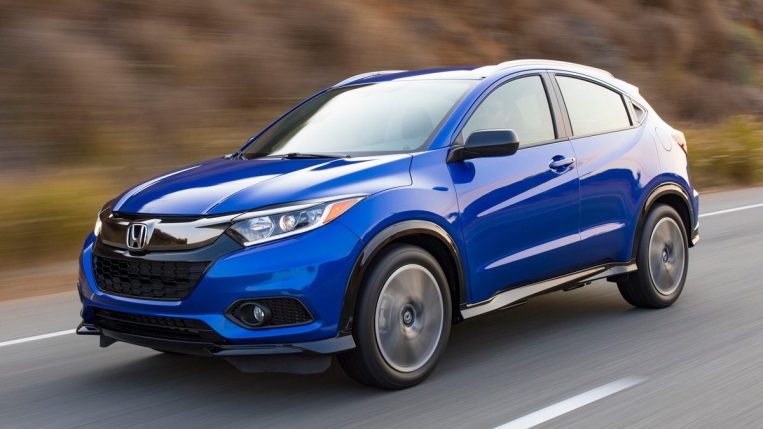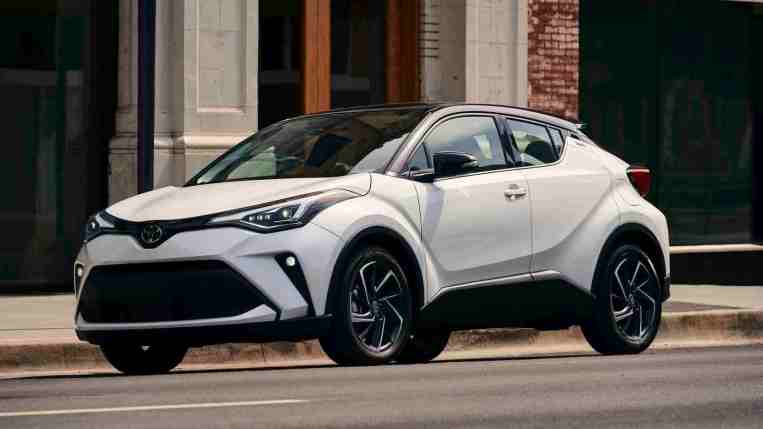The 2021 Honda HR-V and the 2021 Toyota C-HR are the least expensive SUVs from their respective brands. Here’s how they compare.
2021 Honda HR-V

2021 Honda HR-V Starting Price: $21,220 | Price Yours or View listings near you
Above Average: Exceptionally roomy interior; versatile cargo-carrying capability; good gas mileage.
Below Average: Touchscreen infotainment interface; sluggish acceleration; active-safety features not standard on lower trims.
Consensus: With above-average fuel economy and a tempting price, the Honda HR-V is a good value for the buyer on a budget. The continuously variable transmission (CVT) requires lots of engine rpm to climb hills. However, the flexible interior on this Honda is great for hauling passengers and cargo.
2021 Toyota C-HR

2021 Toyota C-HR Starting Price: $21,545 | Price Yours or View listings near you
Above Average: Expressive styling; strong resale value and reliability; sporty handling.
Below Average: Front-wheel drive only; weak engine; tight rear seat; small cargo hold.
Consensus: The FWD-only 2021 Toyota C-HR is more of a tall hatchback than a baby SUV. It boasts lots of style and standard equipment, although its powertrain lacks verve and all-wheel drive availability.
HR-V vs. C-HR: Urban-Friendly Baby SUVs
Honda HR-V
The HR-V is Honda’s smallest and least expensive SUV. The HR-V is deceptively roomy, though, particularly its rear seat. Dubbed “Magic Seat” by Honda, its multi-folding capability allows for exceptional cargo-carrying versatility. It’s standard on all four trim levels: LX, Sport, EX, and EX-L.
The sole engine is a 141-horsepower 1.8-liter 4-cylinder with 127 lb-ft of torque that pairs with a continuously variable transmission (CVT). Front-wheel drive is standard and all-wheel drive (AWD) is optional. The HR-V is not quick, but fuel economy is good: 28/34 mpg city/highway (FWD) and 27/31 mpg (AWD).
Honda’s 7-inch infotainment display is on all but the base LX and includes Apple CarPlay and Android Auto but lacks a tuning knob and menu shortcut buttons. Navigation is not offered. The LX is sparsely equipped; the Sport features unique design elements along with a smattering of additional features.
We recommend the EX or EX-L, which get the HR-V’s bundle of active-safety features known as Honda Sensing. This suite includes forward-collision warning with automatic braking, lane-departure warning, lane-keep assist, and adaptive cruise control. HR-V can also be had with heated seats, a sunroof, and Honda’s LaneWatch, which displays onto the center screen a live feed of the right-side blind-spot zone when the right turn signal is activated.
Toyota C-HR
The Toyota C-HR stands out from other neo-SUVs with its coupe-like styling. The wide rear pillars, though, make for a claustrophobic rear seat, where legroom already is tight. Don’t expect to carry much cargo, either, as the C-HR has just 19 cubic feet of luggage space or 37 cubic feet with the rear seats folded.
The C-HR’s sporty handling lives up to the promise of the exterior styling, but the 2.0-liter engine is on the weaker side and pairs with an un-sporty CVT automatic. The fuel economy is good but not class-leading. No other powertrains are available, nor is AWD offered.
A robust suite of safety and driver-assist features come standard. They include forward-collision warning with pedestrian detection and automatic braking, lane-keeping assist, lane-centering, automatic high beams, and adaptive cruise control. Blind-spot monitoring and rear cross-traffic alert are included on all but the base trim.
All C-HR grades get an 8-inch touchscreen with Apple CarPlay, Android Auto, and Amazon Alexa. To no one’s surprise on a Toyota product, the C-HR also boasts strong resale values and reliability.
Similarities
Small footprint; modest horsepower; CVT transmissions.
2021 Honda HR-V Advantages
Rear seat room; cargo carrying; available AWD; NHTSA 5-star safety; high resale value.
2021 Toyota C-HR Advantages
Sporty handling; reliability; strong resale value; 2-year free scheduled maintenance.
Which One is Right for Me?
The 2021 Honda HR-V is the perfect urban companion that offers all-wheel drive for those desiring enhanced traction in foul weather. The rear Magic Seat gives the HR-V unrivaled flexibility to haul people and cargo.
The 2021 Toyota C-HR’s funky styling may hold sway with some buyers, and its handling is sporty although its powertrain is not. With its tight rear seat and small cargo hold, the C-HR also sacrifices utility to style, and AWD is not offered. It holds further appeal with a robust suite of standard active safety features.
Ready to buy a Honda HR-V or Toyota C-HR? Shop for one on sale now near you
| 2021 Honda HR-V | 2021 Toyota C-HR | |
| Popular Powertrains | ||
| Engine | 1.8-liter I4 | 2.0-liter I4 |
| Horsepower | 141 hp @ 6,500 rpm | 144 hp @ 6,100 rpm |
| Torque | 127 lb-ft @ 4,300 rpm | 139 lb-ft @ 3,900 rpm |
| Transmission | CVT | CVT |
| Fuel Economy | 30 mpg (28 city/34 hwy) | 29 mpg (27 city/31 hwy) |
| Also Available | AWD | n/a |
| Specs | ||
| Warranty | 3 years/36,000 miles | 3 years/36,000 miles |
| Powertrain Warranty | 5 years/60,000 miles | 5 years/60,000 miles |
| NHTSA Overall Safety | 5 stars | 4 stars |
| Max Seating Capacity | 5 | 5 |
| Wheelbase | 102.8 inches | 103.9 inches |
| Overall Length | 170.4 inches | 172.6 inches |
| Width | 69.8 inches | 70.7 inches |
| Height | 63.2 inches | 61.6 inches |
| Turning Diameter | 37.4 feet | n/a |
| Headroom, Front | 39.5 inches | 38.1 inches |
| Headroom, Rear | 38.3 inches | 38.3 inches |
| Legroom, Front | 41.2 inches | 43.5 inches |
| Legroom, Rear | 39.3 inches | 31.7 inches |
| Shoulder Room, Front | 56.8 inches | 49.0 inches |
| Shoulder Room, Rear | 54.5 inches | 52.5 inches |
| EPA Passenger Volume | 100.1 cubic feet | 86.0 cubic feet |
| EPA Cargo Volume | 23.2/57.6 cubic feet | 19.1/37.0 cubic feet |
June 15, 2021 at 04:00AM
https://ift.tt/3gCfrM4
2021 Honda HR-V vs. 2021 Toyota C-HR Comparison - Kelley Blue Book
https://ift.tt/38hkzRl
Honda

No comments:
Post a Comment